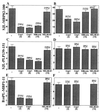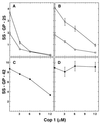Copolymer 1 acts against the immunodominant epitope 82-100 of myelin basic protein by T cell receptor antagonism in addition to major histocompatibility complex blocking
- PMID: 9892685
- PMCID: PMC15188
- DOI: 10.1073/pnas.96.2.634
Copolymer 1 acts against the immunodominant epitope 82-100 of myelin basic protein by T cell receptor antagonism in addition to major histocompatibility complex blocking
Abstract
The synthetic random amino acid copolymer Copolymer 1 (Cop 1, Copaxone, glatiramer acetate) suppresses experimental autoimmune encephalomyelitis, slows the progression of disability, and reduces relapse rate in multiple sclerosis (MS). Cop 1 binds to various class II major histocompatibility complex (MHC) molecules and inhibits the T cell responses to several myelin antigens. In this study we attempted to find out whether, in addition to MHC blocking, Cop 1, which is immunologically cross-reactive with myelin basic protein (MBP), inhibits the response to this autoantigen by T cell receptor (TCR) antagonism. Two experimental systems, "prepulse assay" and "split APC assay," were used to discriminate between competition for MHC molecules and TCR antagonism. The results in both systems using T cell lines/clones from mouse and human origin indicated that Cop 1 is a TCR antagonist of the 82-100 epitope of MBP. In contrast to the broad specificity of the MHC blocking induced by Cop 1, its TCR antagonistic activity was restricted to the 82-100 determinant of MBP and could not be demonstrated for proteolipid protein peptide or even for other MBP epitopes. Yet, it was shown for all the MBP 82-100-specific T cell lines/clones tested that were derived from mice as well as from an MS patient. The ability of Cop 1 to act as altered peptide and induce TCR antagonistic effect on the MBP p82-100 immunodominant determinant response elucidates further the mechanism of Cop 1 therapeutic activity in experimental autoimmune encephalomyelitis and MS.
Figures



Similar articles
-
Novel synthetic amino acid copolymers that inhibit autoantigen-specific T cell responses and suppress experimental autoimmune encephalomyelitis.J Clin Invest. 2002 Jun;109(12):1635-43. doi: 10.1172/JCI15402. J Clin Invest. 2002. PMID: 12070311 Free PMC article.
-
Reversal of experimental autoimmune encephalomyelitis by a soluble peptide variant of a myelin basic protein epitope: T cell receptor antagonism and reduction of interferon gamma and tumor necrosis factor alpha production.J Exp Med. 1994 Dec 1;180(6):2227-37. doi: 10.1084/jem.180.6.2227. J Exp Med. 1994. PMID: 7525850 Free PMC article.
-
Bystander suppression of experimental autoimmune encephalomyelitis by T cell lines and clones of the Th2 type induced by copolymer 1.J Neuroimmunol. 1998 Nov 2;91(1-2):135-46. doi: 10.1016/s0165-5728(98)00166-0. J Neuroimmunol. 1998. PMID: 9846830
-
A review of T-cell receptors in multiple sclerosis: clonal expansion and persistence of human T-cells specific for an immunodominant myelin basic protein peptide.Ann N Y Acad Sci. 1995 Jul 7;756:241-58. doi: 10.1111/j.1749-6632.1995.tb44522.x. Ann N Y Acad Sci. 1995. PMID: 7544075 Review.
-
Therapeutic vaccines in autoimmunity.Proc Natl Acad Sci U S A. 2004 Oct 5;101 Suppl 2(Suppl 2):14586-92. doi: 10.1073/pnas.0404826101. Epub 2004 Aug 12. Proc Natl Acad Sci U S A. 2004. PMID: 15308777 Free PMC article. Review.
Cited by
-
Physicochemical and Biological Examination of Two Glatiramer Acetate Products.Biomedicines. 2019 Jul 3;7(3):49. doi: 10.3390/biomedicines7030049. Biomedicines. 2019. PMID: 31277332 Free PMC article.
-
Repurposing of glatiramer acetate to treat cardiac ischemia in rodent models.Nat Cardiovasc Res. 2024 Sep;3(9):1049-1066. doi: 10.1038/s44161-024-00524-x. Epub 2024 Aug 26. Nat Cardiovasc Res. 2024. PMID: 39215106
-
Glatiramer acetate (Copaxone) induces degenerate, Th2-polarized immune responses in patients with multiple sclerosis.J Clin Invest. 2000 Apr;105(7):967-76. doi: 10.1172/JCI8970. J Clin Invest. 2000. PMID: 10749576 Free PMC article. Clinical Trial.
-
Glatiramer acetate for treatment of MS: regulatory B cells join the cast of players.Exp Neurol. 2011 Jan;227(1):19-23. doi: 10.1016/j.expneurol.2010.10.009. Epub 2010 Oct 20. Exp Neurol. 2011. PMID: 20969865 Free PMC article.
-
Autoantibodies to myelin basic protein catalyze site-specific degradation of their antigen.Proc Natl Acad Sci U S A. 2006 Jan 10;103(2):281-6. doi: 10.1073/pnas.0509849103. Epub 2005 Dec 30. Proc Natl Acad Sci U S A. 2006. PMID: 16387849 Free PMC article.
References
-
- Altman A, Coggeshall K M, Mustelin T. Adv Immunol. 1990;48:227–360. - PubMed
-
- Ullman K S, Northrop J P, Verweil C L, Crabtree G R. Annu Rev Immunol. 1990;8:421–452. - PubMed
-
- Smilek D E, Lock C B, McDevitt H O. Immunol Rev. 1990;118:37–71. - PubMed
-
- Aharoni R, Teitelbaum D, Arnon R, Puri Y. Nature (London) 1991;352:147–150. - PubMed
Publication types
MeSH terms
Substances
LinkOut - more resources
Full Text Sources
Other Literature Sources
Research Materials
Miscellaneous

